Welcome to MYOB Essentials! We know you're excited to explore all the great features in your new product, so we've put together this page to explain how to get around. There are some features that appear on every MYOB Essentials page. These are: | UI Expand |
|---|
| Links at the topAt the top of each MYOB Essentials page you'll find a purple bar with a number of links:  Image Removed Image Removed
- My businesses—click to view your MYOB Essentials businesses. You can also add a new business or switch to an existing one from (that you are signed up for). For more information see Using multiple businesses.
- Settings menu (
 Image Removed )—click your business name to view the Settings menu. From this menu, you can access various settings (such as your Business details, GST settings and Import/Export), details about your subscription, and your accounts list. You can also view your serial number and log out of MYOB Essentials. For more information, see Settings. Image Removed )—click your business name to view the Settings menu. From this menu, you can access various settings (such as your Business details, GST settings and Import/Export), details about your subscription, and your accounts list. You can also view your serial number and log out of MYOB Essentials. For more information, see Settings.
Links at the bottomAt the bottom of each MYOB Essentials page are the following links: - Privacy policy—click to view the privacy policy statement for MYOB.
- About us—click to find out more about MYOB.
- Contact us—click to find out how to contact the MYOB Essentials team.
|
| UI Expand |
|---|
| title | MYOB Essentials menu |
|---|
| You'll use the main menu bar to access most areas of MYOB Essentials.  Image Removed Image Removed
If you click an item on the menu bar that has an arrow (  Image Removed ) next to it, a list of related options appears. You can then click any of these to go directly to that section. Image Removed ) next to it, a list of related options appears. You can then click any of these to go directly to that section. | |
|---|
| Dashboard | View the dashboard, which shows a snapshot of your business. | Sales | View the list of quotes created in MYOB Essentials | | View the list of invoices created in MYOB Essentials. | | View a list of your items, which are products or services that you buy or sell. | | Create invoices to send to your customers. | | Enter a payment made by a customer for an invoice. | | Create invoice returns—customer credits or refunds for goods returned, services not used or received. | | Apply a customer return to an invoice or refund the money to a customer. | | See a list of your sales history for a specified period of time. | | Send statements to your customers showing their current balance. | Purchases | View the list of bills recorded in MYOB Essentials. | | View a list of your items—products or services that you buy or sell. | | Create bills to record the purchases you make from your business suppliers. | | Enter a payment for a bill. | | Create a return for a supplier—returns are credits or refunds for goods returned, services not used or received. | | Apply a supplier return to a bill or record it as a refund from a supplier. | | See a list of your purchase history for a specified period of time. | Banking | View all the bank transactions that have been brought in on bank feeds or imported manually using bank statements. | | Manually reconcile transactions that won’t be matched to an imported bank transaction. | | Set up the rules you use to automatically allocate imported bank transactions. | | Enter withdrawals and payments that are not associated with your business suppliers. | | Enter deposits received from sources other than customer sales. | | Record any transfers you’ve made from one bank account to another. | | View transactions on each of your bank accounts over a specified period. | Contacts | View a list of your contacts—customers, suppliers, employees or general contacts. | | Create a new contact. | Payroll | Open the pay centre screen, where you can select dates and employees, and do the pay run. | - Pay superannuation (Australia only)
| Get a file containing all of your contribution data that you can use to make contribution payments through MYOB's super portal. | | View a list of your employees. | - IRD monthly returns
(New Zealand only)
| Print the reports you need to lodge with the IRD each month—Employer deductions (IR345), Employer monthly schedule (IR348) and KiwiSaver employee details (KS1). | | View, print or email individual employees’ payslips and view a summary of each of your past pay runs. | | View a summary or detail report of your payroll over a specified period of time. | - PAYG payment summaries
(Australia only)
| Produce PAYG payment summaries for your employees and lodge them electronically with the ATO. | | View and change your payroll settings, including which bank account you use to pay wages, payslip display options, and payslip email settings. | Reports | View a list of all the reports you can create in MYOB Essentials. | | In tray | Upload your supplier invoices to your In tray and save time on data entry by using them to create bills. | Help & Support  Image Removed Image Removed | View this help centre. The help centre will open at a help topic that is relevant to your current MYOB Essentials page. | | Open the getting started panel and view a quick tutorial of the features of the current MYOB Essentials page. | | Visit the MYOB Essentials videos page and watch video tutorials for different features and concepts. | | Visit the MYOB Essentials blog, to learn about new features and other topics of interest to MYOB Essentials users. | | Visit this help centre. The help centre will open at its main page where you can search, browse or contact support. |
|
There are also features that you can use on many pages. For example: | UI Expand |
|---|
| title | Searching and filtering |
|---|
| 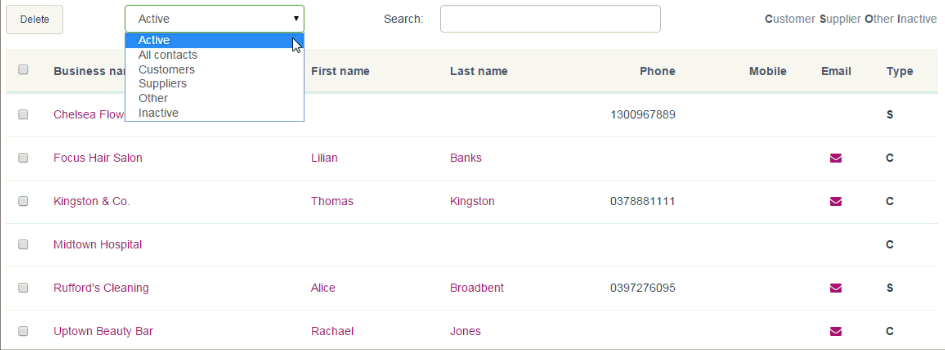 Image Removed Image Removed
Most MYOB Essentials pages have a search field. As you type your search term, the list on the page is updated to match your text. You can also choose from the filters that are next to the search field. | UI Text Box |
|---|
| Use searching in combination with sorting If searching and filtering gives you a long list of results, you might want to sort the list by one of the column headings. For more information see Sorting by column. |
|
| UI Expand |
|---|
| 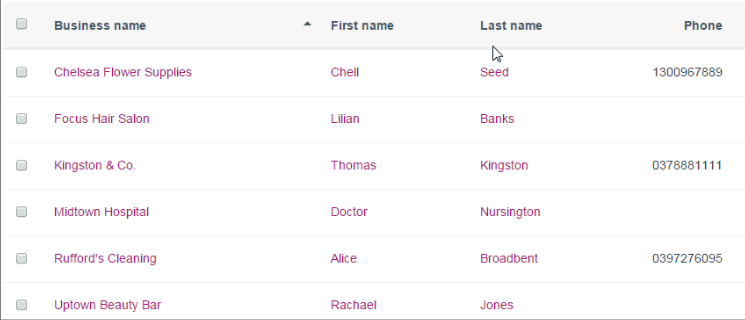 Image Removed Image Removed
By clicking a column heading, you can re-sort the information in the list by that column. For example, in the contacts list, you can click the First Name column heading to sort the list in alphabetical order by contacts’ first names. |
| UI Expand |
|---|
| title | Selecting and deselecting options |
|---|
| You can select options or list items by clicking the checkbox to the left of them. A tick will appear in the checkbox (  Image Removed ). To deselect an option, click the checkbox again. The tick will disappear ( Image Removed ). To deselect an option, click the checkbox again. The tick will disappear (  Image Removed ). Image Removed ). |
| UI Text Box |
|---|
| Month-end tasks While you’re exploring MYOB Essentials, you may also want to have a look at our suggested Month-end tasks. |
| UI Text Box |
|---|
| | AccountRight Premier 2018.3 and later only |
If your business deals in multiple currencies, you’ll be excited to learn we’ve introduced multi-currency functionality into AccountRight. It’s still in beta which means some of the functions aren’t ready yet. We’ve started with purchases (imports), but sales (exports) functionality is coming soon. Want to give it a try? We’d love you to have a play and see what it currently can—and can’t—do. This is just the beginning, there’s lots more to come. If you want to learn about our multi-currency beta program, where it’s headed, or how you can get involved, visit our website. Whether you’re experienced with multi-currency or not, open AccountRight’s sample company file and see what it’s all about. If you have any questions or feedback, let us know on the community forum. Using a classic AccountRight version? If you’ve used multi-currency in AccountRight Classic (v19 and earlier), you’ll notice some changes. And by ‘changes’ we mean ‘exciting improvements’. Because it’s still in beta, you’re not yet able to upgrade classic AccountRight company files that have used multi-currency, but we’re working on it. We’ll let you know when it’s ready. Setting up multi-currencyTo use the multi-currency features, you’ll need to turn on the multi-currency preference. You can then enter exchange rates, choose your suppliers’ default currencies, and create foreign currency bank accounts. Let’s get started. | UI Expand |
|---|
| title | 1. Turn on the multi-currency preference |
|---|
| - Go to the Setup menu and choose Preferences.
- On the System tab, select the option I Deal in Multiple Currencies.
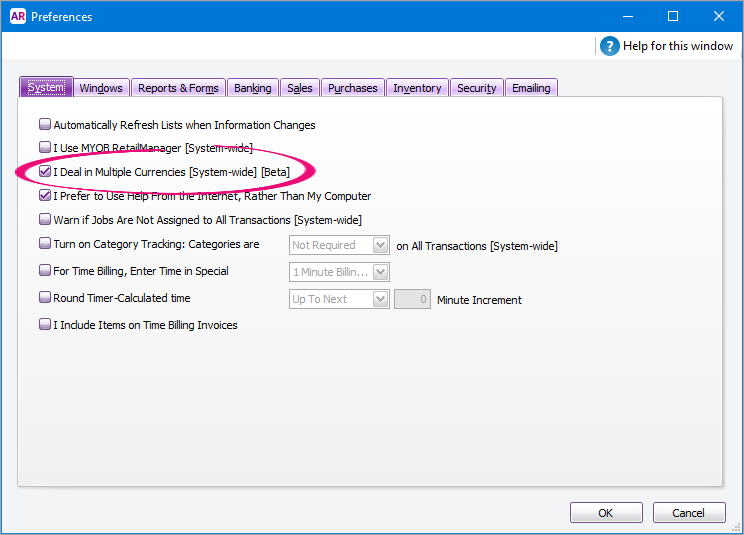 Image Added Image Added Click OK. | UI Text Box |
|---|
| Once you turn this preference on in the sample file, you won't be able to turn it off (AccountRight 2018.2 only). |
By turning on this preference: - Foreign currencies now available from the Lists menu.
- Currency information is available in supplier cards and the Enter Purchases, Pay Bills, Spend Money, Receive Money, Purchases Register, Reconcile Accounts, and Find Transactions (Bill tab) windows.
- A new income account (4-9999 Currency Gain/Loss) is created to track gains and losses from exchange rate changes.
|
| UI Expand |
|---|
| title | 2. Set your exchange rates |
|---|
| Currently you need to manually set exchange rates. In a future release, this will be automated using online exchange rates. The exchange rate will be used when recording and paying bills, or a custom exchange rate can be used per transaction. - Go to the Lists menu and choose Currencies.
- Use the Search field to find the currency by currency code or name.
- Enter the currency’s Exchange Rate. The rate represents the foreign value for $1 of local currency, e.g. 1 AUD = entered exchange rate.
 Image Added Image Added - Click OK.
- Repeat for other currencies.
|
| UI Expand |
|---|
| title | 3. Set the default currency for each supplier |
|---|
| You can set a supplier’s default currency in their card. If needed, you can choose a different currency when recording purchases. - Go to the Card File command centre and click Cards List.
- Click the Supplier tab.
- Click the blue zoom arrow to open a supplier’s card.
- On the Profile tab, select the supplier’s Default Currency. Here’s an example:
 Image Added Image Added - Click OK.
- Repeat for other suppliers.
|
| UI Expand |
|---|
| title | 4. Create foreign bank accounts |
|---|
| If you have a bank account in a foreign currency, you can create a matching account in AccountRight. Currently these accounts can only be Bank type accounts, but credit card type accounts will be supported in a future update. Once an account is created, you can’t change the account type or currency. - Go to the Accounts command centre and click Accounts List.
- Click New.
- Select Bank as the Account Type.
- Enter an Account Number and Account Name.
Select the Currency for this account. Here’s an example account:
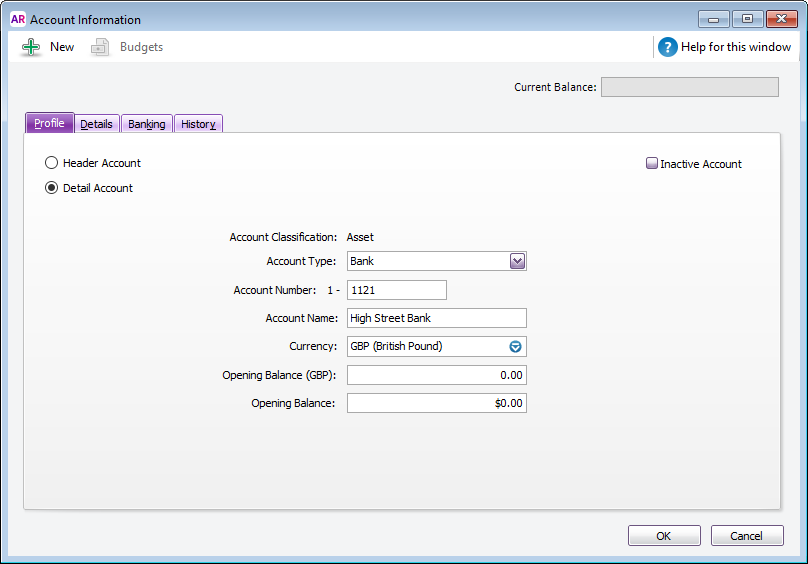 Image Added Image Added | UI Text Box |
|---|
| Opening balances If the account has a balance, you can enter it here in both foreign and local values. You'll need to manually calculate the local value based on the currency's exchange rate. |
- Click the Details tab.
- Select the Tax/GST Code for this account. This must be a code with a 0% tax rate. Check with your accounting advisor if unsure.
- Click OK.
- Repeat for additional foreign bank accounts.
Once an account has been used in a transaction, the Accounts List window shows the account balance in your local currency.  Image Added Image Added
To see the account’s foreign currency balance, double-click to open the account. 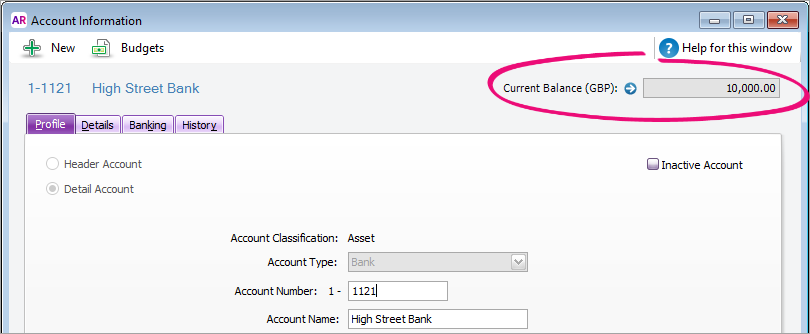 Image Added Image Added
|
Transacting in multiple currenciesNow that you're set up, you can start recording multi-currency purchases. But first, you might need to transfer funds into a foreign currency bank account (created during the setup above). Let's step you through this, and also how to record and pay bills. | UI Expand |
|---|
| title | Transfering funds into foreign bank accounts |
|---|
| Use a Receive Money transaction to transfer funds from one AccountRight bank account into a foreign bank account. Here’s how: - Go to the Banking command centre and click Receive Money.
- In the Deposit to Account field, select the foreign bank account. The Currency field updates based on the account chosen, and the exchange rate is shown.
- If required, change the exchange rate (click the blue zoom arrow
 Image Added next to the Currency field). Changing the rate will result in an unrealised gain or loss. Image Added next to the Currency field). Changing the rate will result in an unrealised gain or loss.- Changing the Default rate will update the rate set against the currency list.
- Setting a Custom rate will use that rate for this transaction only.
 Image Added Image Added
- Enter the Amount of the transfer (in foreign currency).
- On the first line of the transaction, select the Acct. No. the funds are coming from.
- The local Amount is calculated and cannot be changed.
- The foreign currency Amount is copied from what you entered above. This can be changed, if needed.
- Ensure the correct Tax/GST code is selected. Here’s an example transaction:
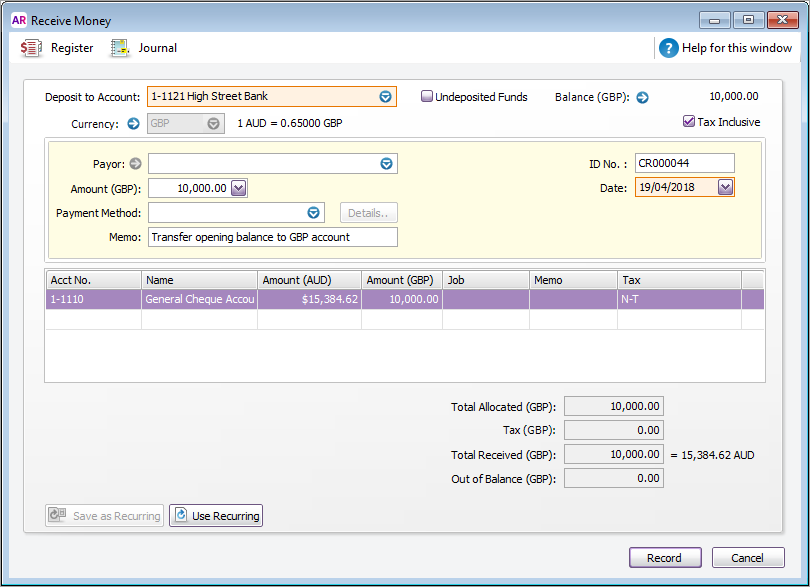 Image Added Image Added - Click Record.
|
| UI Expand |
|---|
| title | Entering foreign currency purchases |
|---|
| By turning on the multi-currency preference as described earlier, currency information is available when recording purchases (quotes, orders and bills). This means you’ll see the purchase value in both local and foreign currencies. The default exchange rate set against the currency is used, or you can choose a custom rate. | UI Text Box |
|---|
| | Only the Item and Service layout is currently supported, and we’re still working on the Receive Items purchase type. |
OK, let’s create a foreign currency purchase.
- Go to the Purchase command centre and click Enter Purchase.
- Click Layout and choose Item or Service.
- Choose the Purchases Type (Quote, Order or Bill).
- Choose the Supplier. The default currency set in their card is shown. If required, you can click the dropdown arrow
 Image Added to select a different currency for this purchase. Image Added to select a different currency for this purchase.
 Image Added Image Added - If required, change the exchange rate (click the blue zoom arrow
 Image Added next to the Currency field). Image Added next to the Currency field).
- Changing the Default rate will update the rate set against the currency list.
- Setting a Custom rate will use that rate for this transaction only.
 Image Added Image Added - Enter the details of the purchase.
- Only the foreign currency amount can be entered. The local currency amount is calculated for you.
- Only 0% tax/GST codes can be assigned in foreign currency transactions.
Here’s an example:
 Image Added Image Added - (Optional) Recap the transaction (Edit menu > Recap Transaction) to view journal postings in local currency, then click Close.
 Image Added Image Added - Click Record.
The way you change a quote or order into a bill remains the same. Learn more about Changing the purchase type. |
| UI Expand |
|---|
| title | Paying foreign currency bills |
|---|
| Paying foreign currency bills is similar to paying other bills, but with some handy extras. Let’s take a look: - Go to the Purchases command centre and click Pay Bills.
- Choose the Pay from Account. This can be a local or foreign currency bank account.
- Choose the Supplier. Their open bills are listed.
- Bills are grouped by currency (if you’ve recorded bills in multiple currencies).
- Click a currency to see those bills - the exchange rate and amounts on the window update accordingly.
- The Owed columns and Total Paid field show local and foreign values.
 Image Added Image Added - If required, change the exchange rate (click the blue zoom arrow next to the Currency field). Changing the rate will result in a realised gain or loss.
- Changing the Default rate will update the rate set against the currency.
- Setting a Custom rate will use that rate for this bill payment only.
 Image Added Image Added
- In the Amount field, enter the total foreign currency amount being paid.
In the Applied column, enter how much of the payment you want to apply to each purchase in that currency.
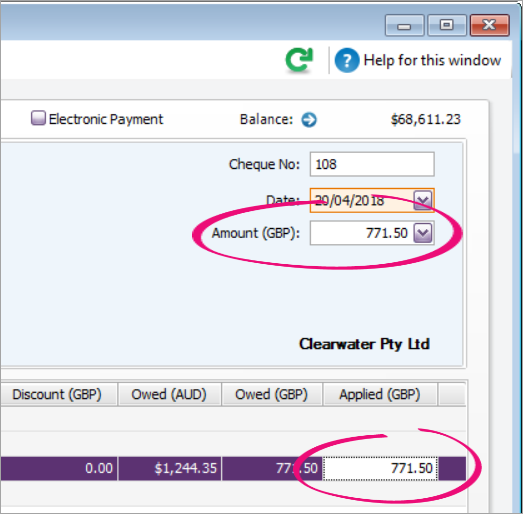 Image Added Image Added | UI Text Box |
|---|
| Click Pay All  Image Added to pay all a supplier’s bills for the same currency. The total payment amount appears in the Amount field and the individual payment amounts are applied to each open purchase in that currency. Image Added to pay all a supplier’s bills for the same currency. The total payment amount appears in the Amount field and the individual payment amounts are applied to each open purchase in that currency. |
Ensure the Out of Balance is zero. An out of balance will show if the Total Paid and Amount fields don’t match.
Notice the converted local value is also shown.
 Image Added Image Added - (Optional) Recap the transaction (Edit menu > Recap Transaction) to view journal postings in local currency, including any realised gains or losses. Then click Close.
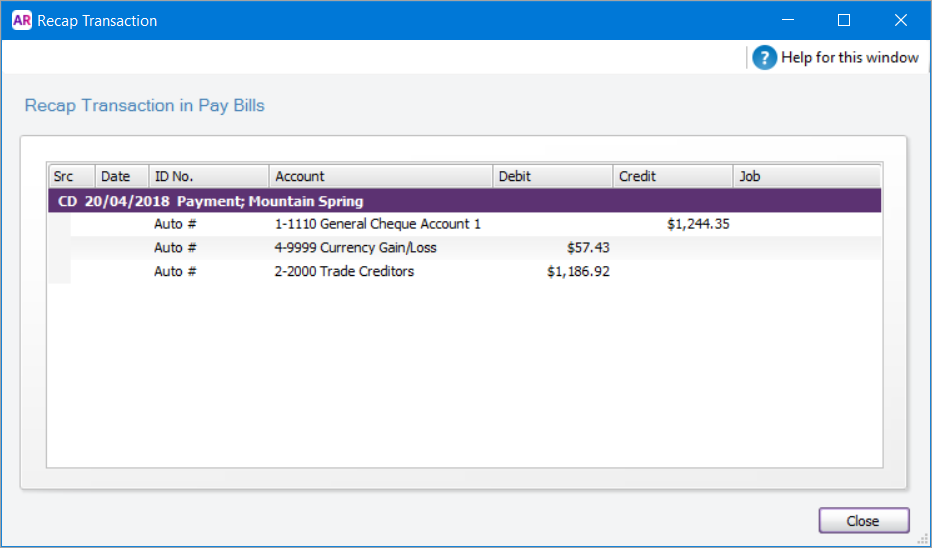 Image Added Image Added - Click Record.
|
| UI Expand |
|---|
| title | Reporting on foreign currency purchases |
|---|
| We’re still working on adding multi-currency info to AccountRight’s reports. But we’ve enhanced the Purchases Register to give you some great insights into your multi-currency transactions. Once you’re in the Purchases Register (accessible from the Purchases command centre), here’s just a few things you can do. | UI Text Box |
|---|
| | Clicking Print from the Purchases Register will display the Purchases Register Detail report in local currency values only. |
Try this | Details |
|---|
Expand the window to see all columns | We’ve made the Purchases Register window wider to accommodate the new foreign exchange columns Amount (FX) and Amt Due (FX) . (click to enlarge)  Image Added Image Added
| Group by currency | Right-click the Currency column and choose Group By This Column . 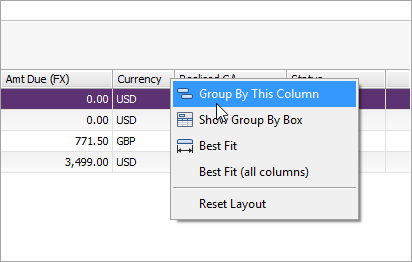 Image Added Image Added
Currencies are then grouped with subtotals. (click to enlarge)  Image Added Image Added
| Group by multiple levels | Right-click and column heading and choose Show Group By Box . Drag the columns you want to group by, such as by supplier, then by currency.
(click to enlarge) 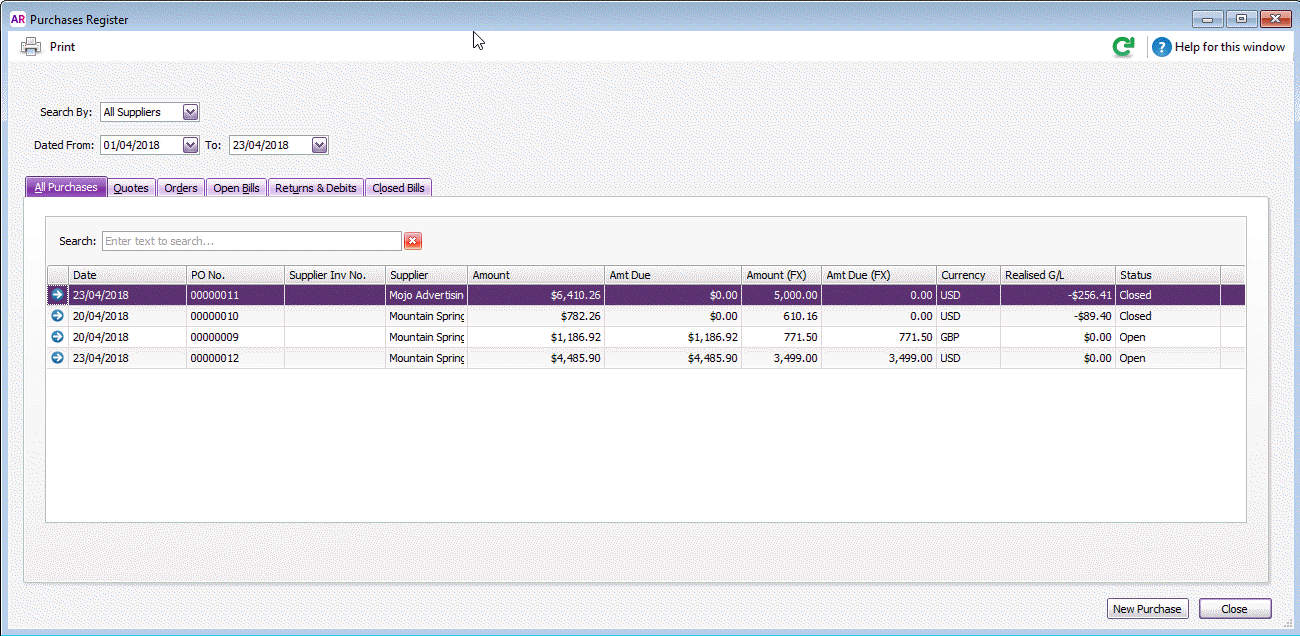 Image Added Image Added
| View your realised gains and losses | The Realised G/L column shows any gains or losses (in local currency) resulting from exchange rate changes. 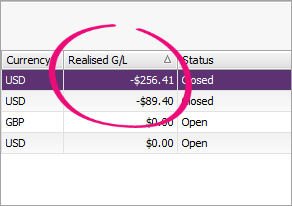 Image Added Image Added
Negative values are losses, and positive values are gains. | Analyse your data further | Copy info from the Purchases Register to paste into Excel for further analysis. Right-click the list and choose Copy to Clipboard , then paste into Excel. (click to enlarge) 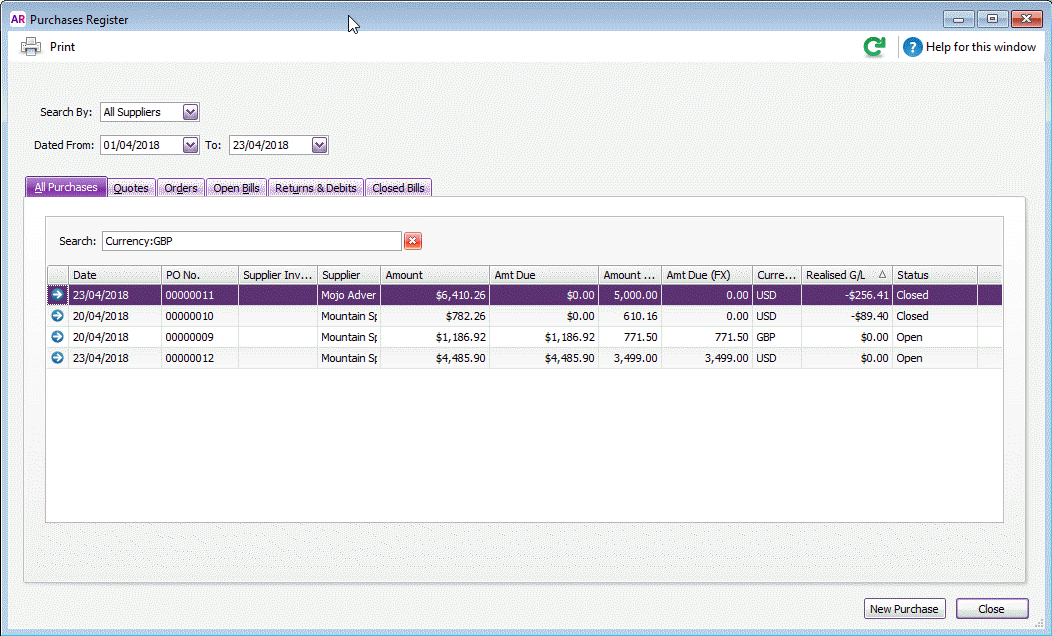 Image Added Image Added
|
|
| HTML |
|---|
<h2><i class="fa fa-comments"></i> FAQs</h2><br> |
| UI Expand |
|---|
| title | What can and can’t be done with multi-currency in the AccountRight 2018.2 sample company file? |
|---|
| What can and can’t be done with multi-currency in the AccountRight 2018.2 sample company file? CAN do | CAN’T do (yet) |
|---|
Create a quote, purchase order and bill for Item and service layouts. Set a default currency on a supplier card. Set default exchange rates from the currency list. Set a custom exchange rate for a specific transaction. Create and reconcile a bank account using a foreign currency. Create Spend Money and Receive Money transactions using the foreign bank account. Pay foreign bills and track the realised gain or loss. Raise and settle debits against foreign bills. View transactions grouped and subtotalled by currency in the Purchases Register.
| Create foreign sales quotes, orders and invoices. Receive items before being billed for them. Create foreign purchases using the Professional and Other layouts. Create foreign recurring purchases. View foreign currencies in forms and reports (but you can track the realised gains and losses from the Purchases Register window). - View foreign currency values in printed and emailed purchases (orders, quotes, bills and remittance advices)
Upgrade AccountRight v19 or earlier company files (also known as classic AccountRight versions) that use or previously used multi-currency
|
|
| UI Expand |
|---|
| title | How is multi-currency in AccountRight 2018.2 different to AccountRight v19? |
|---|
| How is multi-currency in AccountRight 2018.2 different to AccountRight v19?We haven’t just replicated multi-currency from v19, which means that multi-currency is easier to set up and use. Some changes you might notice: - Exchange rates appear in the same format as those published in media (that is, the opposite of AccountRight v19).
- You can use multiple currencies for each supplier card. You don't need a different card for each currency you transact with for that supplier.
- You don't need to set up a list of currencies, a complete list is available for you, you just need to enter the exchange rate.
- You don't need to set up or use foreign currency trade creditor accounts or foreign currency exchange accounts. All transactions use your current trade creditor account.
- Currently, you can only create foreign bank accounts (that is, those set up with the Bank account type). Foreign credit card accounts will be available soon.
- You can only set the base currency as AUD and NZD in AccountRight 2018.2.
- Currency lists show all available currencies. A refined list of preferred currencies is planned for future releases.
|
| UI Expand |
|---|
| title | How do I sort my suppliers by currency? |
|---|
| How do I sort my suppliers by currency?You can add the Currency column to the Cards List so you can group your suppliers by currency. Here's how: - Go to the Card File command centre and click Cards List.
- Click the Supplier tab.
- Right-click a column heading and choose Column Chooser.
- Double-click Currency from the list. The Currency column is added to the list. If you like, click and drag the column heading to move the column to a new position.
- Right-click the Currency column heading and choose Group By This Column.
 Image Added Image Added
Learn more about searching, filtering and grouping in the Cards List. |
|